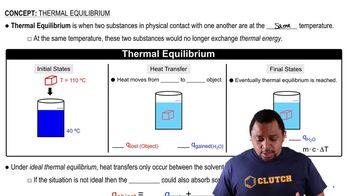Here are the essential concepts you must grasp in order to answer the question correctly.
Balanced Chemical Equation
A balanced chemical equation represents a chemical reaction with equal numbers of each type of atom on both sides of the equation. This ensures the law of conservation of mass is upheld, meaning that matter is neither created nor destroyed during the reaction. Balancing involves adjusting coefficients in front of the chemical formulas to achieve this equality.
Recommended video:
Balancing Chemical Equations
Exothermic Reaction
An exothermic reaction is a type of chemical reaction that releases energy, usually in the form of heat, to its surroundings. This occurs when the total energy of the products is lower than that of the reactants, resulting in a net release of energy. Understanding this concept is crucial for predicting temperature changes and the direction of the reaction.
Recommended video:
Endothermic & Exothermic Reactions
Equilibrium State
The equilibrium state in a chemical reaction refers to the point at which the rates of the forward and reverse reactions are equal, leading to constant concentrations of reactants and products over time. In the context of the decomposition of gaseous A to B, recognizing the equilibrium helps in understanding how the system behaves under different conditions, such as changes in temperature or pressure.
Recommended video:




